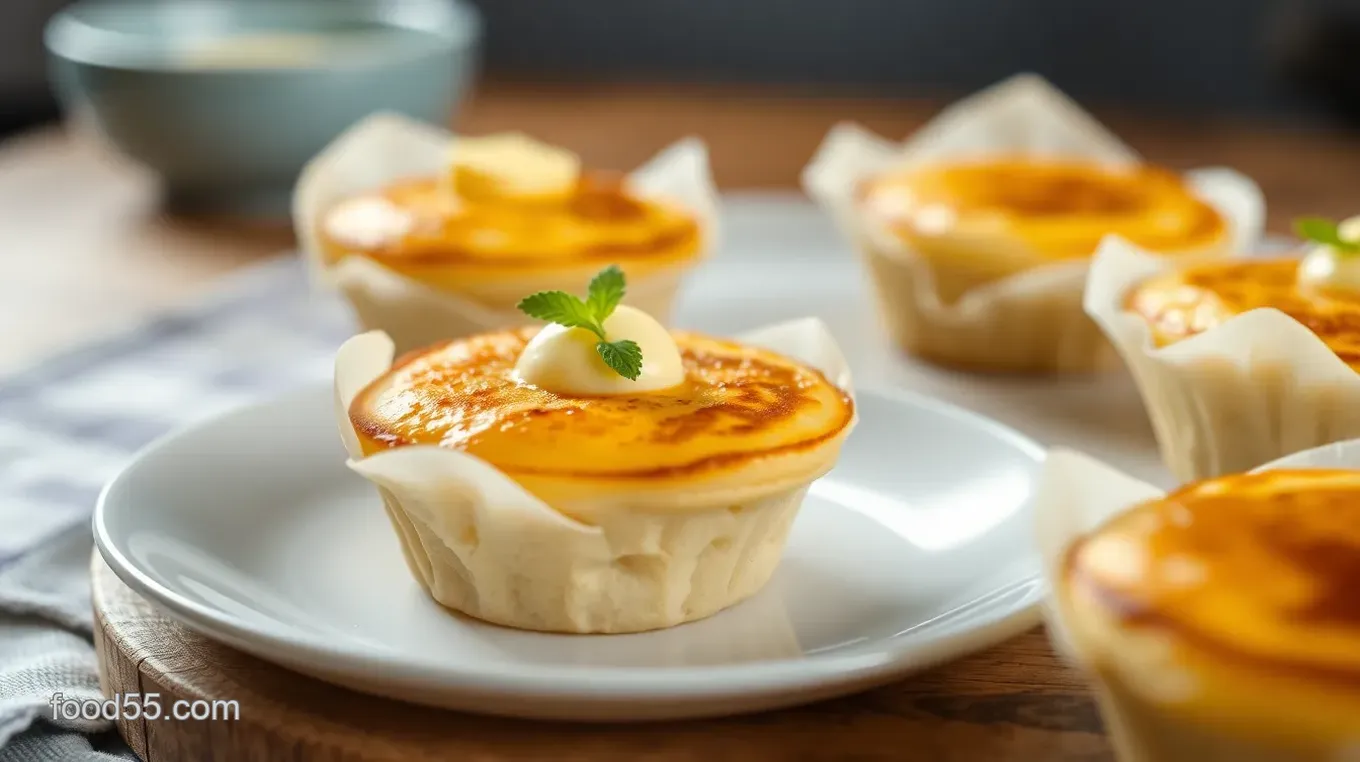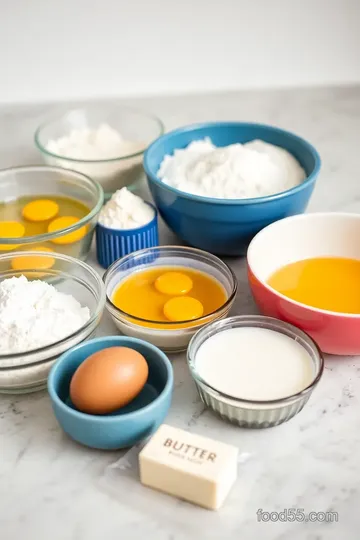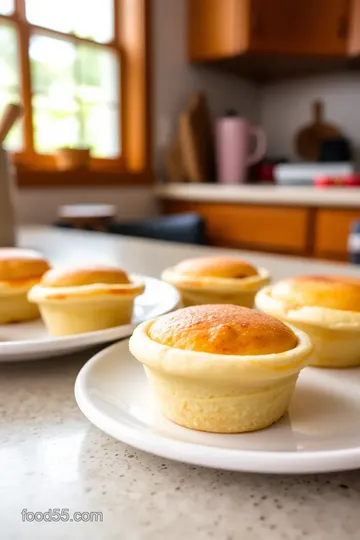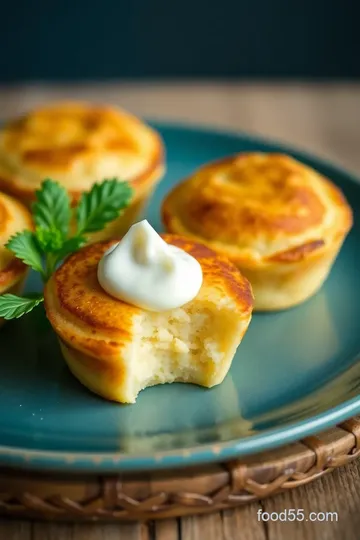Fluffy Pancake Cups: Breakfast Made Easy!
Craving a quick, delightful breakfast? Discover how to bake fluffy pancake cups in 18 minutes that everyone will love! Perfect for busy mornings!

- Fluffy Pancake Cups: Breakfast Made Easy!
- The Journey of Fluffy Pancake Cups
- Nutritious and Delicious: Benefits of Fluffy Pancake Cups
- Final Thoughts Before We Get Cooking
- Your Go-To Essential Ingredients Guide for Fluffy Pancake Cups
- Bake Fluffy Pancake Cups in 18 Minutes: Your New Breakfast Favorite!
- Bake Fluffy Pancake Cups in 18 Minutes: A Breakfast Delight!
- Recipe Card
Fluffy Pancake Cups: Breakfast Made Easy!
Oh my gosh, let me tell you about the morning i discovered fluffy pancake cups . you know those days where you oversleep, and breakfast just seems impossible? that was me last saturday.
I woke up late and thought, “ain’t nobody got time for flipping pancakes!” but then, i remembered this awesome recipe, and i was able to bake fluffy pancake cups in 18 minutes .
Seriously, 18 minutes! sounds like a dream, right?
These mini pancake muffins are total game changers. they save time, and everyone in the family can grab one on the way out the door.
Plus, who doesn’t want a breakfast that’s soft, fluffy, and ready to go? this is definitely my new go-to for quick breakfast ideas when the clock is ticking.
The Journey of Fluffy Pancake Cups
So, where did these little gems come from? historically, pancakes are as classic as apple pie in american kitchens. they evolved from simple mixtures of flour and water in ancient times to our beloved fluffy stacks today.
Fast forward to now, and we’ve got trendy pancake cups, perfect for the fast-paced lifestyle we live.
These pancake cups have taken off, becoming a popular choice for brunch gatherings and even birthday breakfasts. and guess what? they are ridiculously easy to whip up.
Seriously easy. you won't need any ninja chef skills here.
Prep time? A breezy 10 minutes. Cook time? Just 8. Total time is 18 minutes. So you can go from sleepyhead to breakfast champion in less time than it takes to brew a cup of coffee!
When it comes to costs, you're looking at barely a few bucks for a dozen pancake cups. That's a sweet deal, especially when feeding the crew!
Nutritious and Delicious: Benefits of Fluffy Pancake Cups
Here’s the kicker: these pancake cups are not just tasty; they’re also fairly healthy! packed with whole grains and customizable toppings, you can craft them to fit your family's needs.
You could even transform them into healthy pancake alternatives by swapping regular flour for whole wheat or gluten-free options.
These little delights are perfect for all sorts of occasions. whether it’s a lazy sunday brunch with the family, a birthday breakfast surprise, or even a fun treat for kids during playdates, they’ve got you covered.
Plus, they have a great fluffy pancake texture that kids love. seriously, who wouldn’t want to eat pancake muffins?
And the best part? you can get creative with pancake toppings! fresh fruit, maple syrup, or even whipped yogurt on top for a gourmet touch.
The possibilities are endless, making these pancake cups a fun pancake recipe for gatherings and get-togethers.
Final Thoughts Before We Get Cooking
So, are you ready to dive into the world of pancake muffin variations ? say goodbye to boring breakfasts and hello to simple baking recipes for beginners .
These pancake ideas for kids will surely be a hit, and can be prepped ahead for those busy mornings .
Stay tuned because up next, we’ll dive into the ingredient list you need to make your new favorite breakfast cups. Trust me; you want to stick around for this! Happy cooking!

Your Go-To Essential Ingredients Guide for Fluffy Pancake Cups
Who doesn't love a good pancake, right? i mean, they’re little pillows of happiness, especially when they’re fluffy ! if you're aiming to bake fluffy pancake cups in 18 minutes , let’s get you started with the basics you’ll need to whip up some delicious mini pancake muffins.
Trust me, having the right ingredients and tools is key to serving up these satisfying breakfast cup recipes!
Premium Core Components
Let’s kick things off with the core ingredients essential for fluffy pancakes. we're talking about 1 cup (125g) of all-purpose flour, 2 tablespoons (25g) of granulated sugar, and a few leavening agents.
Here’s why these ingredients matter:
-
Quality Indicators: Choose a flour that feels soft and is labeled "all-purpose." Freshness is key, so check the expiration date. Granulated sugar should be white and free-flowing.
-
Storage guidelines: keep flour in an airtight container in a cool, dark place. it'll last about 1 year . sugar can live indefinitely, but it’s best to store it in a dry spot.
Nothing worse than clumpy sugar!
-
Freshness Tips: For the best pancakes, use fresh baking powder and baking soda. A quick test? Mix a bit of water with baking powder; if it bubbles up like a champ, you’re good to go!
Signature Seasoning Blend
Now, what’s a pancake without its signature blend of flavors ? Don’t skip the vanilla extract ! For our pancake cups, you’ll need 1 teaspoon to infuse that sweet, cozy taste.
-
Essential Spice Combinations: Try adding a pinch of cinnamon for a warm touch or a dash of nutmeg for something special!
-
Flavor Enhancers: Ever tried adding a handful of fresh blueberries or chocolate chips? Game changer!
Smart Substitutions
Sometimes you run out of a core ingredient, or maybe you want to make it a bit healthier. Here’s where smart substitutions come in:
-
Common Alternatives: Don’t have buttermilk? No worries! Just mix 1 cup of regular milk with 1 tablespoon of vinegar and let it sit for five minutes.
-
Dietary Modifications: Want to go gluten-free? Switch in a gluten-free flour mix and you’re golden!
-
Emergency Replacements: Out of eggs? You can also use a ¼ cup of applesauce as a binder. Just keep it secret—your kids won’t even notice!
Kitchen Equipment Essentials
To make your pancake cups, you only need a few tools to make life easier:
-
Must-have tools: grab a muffin tin—this is where you’ll shape your mini pancake muffins . a whisk and mixing bowls are a must, and a spatula will help you scrape every last bit of goodness out.
-
Alternative Equipment Options: If you don’t have a muffin tin, use silicone cups for fun shapes! They pop right out, no sticking involved.
-
Preparation Tips: Always grease that muffin tin or use silicone liners. Trust me, no one wants to wrestle with pancake batter stuck in a tin!
-
Storage solutions: if you have leftovers (which is rare!), store them in an airtight container in the fridge. they’ll be good for about 3 days —just pop them in the microwave to reheat.
Wrapping Up for Breakfast Bliss
So there you have it! with these ingredients and tips, you’re well on your way to mastering the art of baking fluffy pancake cups in 18 minutes .
When you have everything prepped and ready, you can take those pancake batter tips and create a fun breakfast your fam will love.
Look forward to sharing your creations! Next up, let’s dive into the detailed recipe . You’ll be flipping pancakes like a pro in no time!
Bake Fluffy Pancake Cups in 18 Minutes: Your New Breakfast Favorite!
Alright, folks! if you're like me and find yourself in a morning scramble, i’ve got just the thing for you: fluffy pancake cups ! seriously, these are a game-changer for quick breakfast ideas .
Imagine sinking your teeth into soft, fluffy pancake muffins that come together in just 18 minutes . yeah, you heard me right! plus, they make brunch gatherings way fancier, but are super easy to whip up.
Essential Preparation Steps
Now, before you dive into baking, let’s talk mise en place . this fancy french term just means “everything in its place.
” make sure to measure out all your ingredients first. you’ll thank me for this later. you don’t wanna be frantically searching for baking powder while your batter is getting antsy!
Time management is also key. You’ll want to spend about 10 minutes prepping and just 8 minutes cooking . That timing is solid gold for making this a quick morning meal.
Organization is everything. Keep your workspace clean, and put all your tools—like the muffin tin, mixing bowls, and whisk—within easy reach. Trust me, a clutter-free kitchen makes everything smoother!
Don’t skimp on safety, friends. always be careful with hot surfaces, and make sure those oven mitts are handy when you’re getting the pancake cups out of the oven.
Temperature control is critical. remember, we’re baking these beauties at 350° f ( 175° c) .
Step-by-Step Process
Let’s break down the baking process into easy, numbered steps:
- Preheat your oven to 350° F ( 175° C) .
- Grab a mixing bowl and get those dry ingredients together: flour, sugar, baking powder, baking soda, and salt. Give it a nice whisk.
- In a separate bowl, mix the buttermilk, egg, melted butter, and vanilla extract. That vanilla will make your kitchen smell heavenly!
- Comb the wet ingredients into the dry. Just stir until they’re mixed— over-mixing = dense pancakes , and nobody wants that!
- Grease your muffin tin or use silicone muffin cups if you’ve got 'em.
- Pour the batter into the cups, filling them about ⅔ full.
- Pop them in the oven and set your timer for 8 minutes . You want them all golden brown, and a toothpick should come out clean when poked in the center.
- Once done, take them out and let them cool for a couple of minutes before devouring!
Expert Techniques
Want to bake fluffy pancakes like a pro? Here are a few expert tips:
- Love for Fluffiness: Let your batter sit for about 5 minutes before baking. This little rest gives the gluten time to relax, creating that impeccable fluffy pancake texture .
- Portion Control: Using a cookie scoop not only helps you fill the muffin tin evenly but ensures even baking.
- Lumps are Cool: Don’t stress about lumps in the batter! A few imperfections are actually good for texture.
- Flavored Twist: Feel free to get creative! Toss in some chocolate chips or play with flavored extracts like almond or maple.
Success Strategies
Okay, let’s chat about some common mistakes to sidestep. first off, never over-mix . you want those lumps! secondly, serve these immediately for the best texture.
Store-bought muffins can feel dense, and that’s a no-no.
For a family-friendly breakfast , why not make these ahead? you could prep the batter the night before and store it in the fridge.
Come morning, just pour it into the muffin tin and bake!
Additional Information
These gourmet pancake cups can easily be topped with fresh fruit or a drizzle of maple syrup , making them perfect for a fun breakfast—especially for kids.
Think of all the pancake ideas for kids you could put together!
So there you have it! you’re all set to bake fluffy pancake cups in 18 minutes . whip up these delightful breakfast treats for your family, or enjoy them as a solo indulgence.
Either way, they’re bound to become a hit in your kitchen! happy cooking!

Bake Fluffy Pancake Cups in 18 Minutes: A Breakfast Delight!
Alright friends, let’s talk about one of the most epic breakfast hacks— bake fluffy pancake cups in 18 minutes ! can you believe how quick and easy that is? seriously, if you’ve ever struggled in the morning, trying to whip up a quick breakfast that’s both fun and filling, you’re in for a treat.
These mini pancake muffins are light, fluffy, and so simple to make. you’ll be the breakfast hero of the house!
Pro Tips & Secrets
So, when it comes to making these delightful pancake cups, i’ve got a few insider tips for you. first off, don’t over-mix your batter! a few lumps are totally fine.
This is the secret to that dreamy, fluffy pancake texture . if you want to save some time in the morning, mix your dry ingredients the night before.
It saves a few minutes and makes the whole process smoother.
Also, the toppings can be a game-changer! think beyond maple syrup . fresh berries, a dollop of yogurt, or even a sprinkle of cinnamon can elevate these little cups to gourmet status.
Trust me, a hint of vanilla pancakes flavors goes a long way towards making breakfast more exciting!
Perfect Presentation
Now, about that all-important presentation . when you pop these pancake cups out of the muffin tin, let’s make them look as good as they taste! you can even sprinkle a bit of powdered sugar on top (who doesn’t love a little sweetness?).
A vibrant fruit garnish not only adds a pop of color but also a refreshing taste. mix and match berries for that instagram-worthy shot that’ll make your followers drool!
Storage & Make-Ahead Tips
If you’re anything like me, busy mornings might mean you need some make-ahead breakfast ideas . these pancake cups are perfect for that! prepare the batter and refrigerate overnight.
Just bake fluffy pancake cups in 18 minutes when you’re ready. if you happen to have leftovers (which i doubt, because they’re that good), store them in an airtight container.
They’ll stay fresh for up to three days. just pop them in the microwave for about 15 seconds to warm them up.
Creative Variations
Gotta love options, am i right? you can get creative with these pancake muffin variations . craving something with a twist? try adding chocolate chips for a sweet treat, or bacon bits for a savory variation.
You can even play with spices like nutmeg or cinnamon for some extra warmth during those chilly mornings. if you want healthier alternatives, swap in some whole wheat flour and add mashed bananas for a natural sweetness.
Complete Nutrition Guide
Now, let’s break it down a little— because food should be delicious and nutritious, right? each fluffy pancake cup comes in at around 120 calories , which isn’t bad for a fun breakfast! with a good balance of protein, fat, and carbs, they make for a solid family-friendly breakfast.
Plus, they’re totally customizable to fit any dietary needs. just swap the ingredients as you like!
Expert FAQ Solutions
You might have some lingering questions, like, “what if mine don’t come out fluffy?” don’t stress! if your pancake cups aren’t as fluffy as you’d like, it may be a sign of over-mixing or your baking powder might be old.
Keep it fresh! a pinch of baking powder goes a long way.
If you want to add some sweetness, start with a tablespoon of sugar in the batter and adjust according to your taste.
And hey! if you’re still on the fence about this recipe, remember, it’s hard to mess up a one-bowl pancake recipe —seriously!
Wrapping It Up
So, there you have it—everything you need to know to whip up the most delightful breakfast cup recipes . these pancake cups are fun, easy, and so versatile.
Perfect for busy mornings or brunch gatherings , they’re sure to satisfy everyone at the table. so grab that muffin tin, rally the family, and give it a go! you're gonna love it.
Enjoy your morning adventures!

Fluffy Pancake Cups: Breakfast Made Easy! Card

⚖️ Ingredients:
- 1 cup (125g) all-purpose flour
- 2 tablespoons (25g) granulated sugar
- 1 teaspoon baking powder
- ½ teaspoon baking soda
- ¼ teaspoon salt
- 1 cup (240ml) buttermilk (or milk with 1 tablespoon vinegar)
- 1 large egg
- 2 tablespoons (30g) unsalted butter, melted
- 1 teaspoon vanilla extract
- Fresh fruit (bananas, blueberries, strawberries)
- Maple syrup or honey
🥄 Instructions:
- Step 1: Preheat the oven to 350°F (175°C).
- Step 2: In a mixing bowl, combine dry ingredients: flour, sugar, baking powder, baking soda, and salt. Whisk until blended.
- Step 3: In another bowl, mix wet ingredients: buttermilk, egg, melted butter, and vanilla extract.
- Step 4: Pour the wet ingredients into the dry ingredients. Stir until just combined; avoid over-mixing.
- Step 5: Grease the muffin tin lightly or use silicone muffin cups.
- Step 6: Pour the batter evenly into the muffin tin, filling each cup about ⅔ full.
- Step 7: Bake in the preheated oven for 8 minutes or until golden brown and a toothpick inserted in the center comes out clean.
- Step 8: Remove from the oven and allow to cool for a few minutes before serving.
Previous Recipe: Ultimate Recipe: Blend Iced Coffee with Creamy Chocolate Bliss
Next Recipe: How to Bake Chicken Patties: Flaky & Delicious, Just Like Grandma's!
